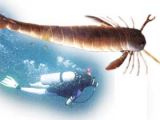Today the largest living arthropod is the Japanese spider crab, Macrocheira kaempferi, which has a leg span of up to 4 m (13 ft) (but the body is just 37 cm (15 in) long) and a weight of up to 20 kg (44 pounds). (Arthropods are invertebrates with an exoskeleton and articulated limbs, like spiders, insects, crustaceans and millipedes).
But this is a dwarf compared to giant fossil sea scorpions. In a new research published in the journal Biology Letters, scientists describe the largest sea scorpion found yet, based on a fossil claw.
The 18-in (46-cm) claw probably had an owner with a body 8-ft (2.46-m) long! Sea scorpions are believed to be the aquatic ancestors of modern scorpions and perhaps many arachnid groups (like spiders) and their closest living relatives are horseshoe crabs.
"We have known for some time that the fossil record yields monster millipedes, super-sized scorpions, colossal cockroaches and jumbo dragonflies, but we never realized, until now, just how big some of these ancient creepy-crawlies were." said co-author Simon Braddy at the University of Bristol in England.
By now, this is the largest discovered arthropod, "beating" another sea scorpion by 14 in (36 cm). The fossil sea scorpion (Jaekelopterus rhenaniae) was encountered in a quarry near Prum (Germany) and the siltstone in which the claw was discovered show that the huge creature inhabited a brackish lagoon or a flood plain lake.
"Most of the remaining fossils from this site are of very small animals-less than 10 cm (4 in)-so I'm a bit puzzled by what this particular sea scorpion specimen would be eating," co-author Erik Tetlie, a Yale paleontologist, told LiveScience.
The sea scorpion is 400 million years old (Early Devonian), a time when enormous arthropods were widespread. This abundance in huge arthropods was explained by two factors: a higher oxygen amount in the atmosphere that permitted them to bypass the limitations imposed by their breathing systems and little competition from vertebrates, found at the beginning of their late blooming evolution. By those times, jaws were a recent acquisition for vertebrates, a trait that later turned them into highly effective predators.
"We already knew that some arthropods and cephalopods-squids and their chums-had jaw-like parts and were predators long before the vertebrates became successful predators. The most exciting thing about the find is really that it shows that the arthropods were not giving over their role as top-level predators without a fight. Still, the exoskeletons that arthropods are known for probably helped bring about their downfall," said Tetlie.
"The internal skeleton of vertebrates grows with the animal, but a hard outer skeleton like in the arthropods have to be shed for the animal to grow. The process of shedding this skeleton, and breathing effectively, are probably two reasons why arthropods could not fully compete with the vertebrates." he explained.
Still, larger arhtropods can be hidden in rock deposits.
"I'm sure we have not yet found the largest sea scorpions," Tetlie said.
Still, the largest species of sea-scorpions is considered Pterygotus, the size of a crocodile: it could have reached 2.8 m (9.3 ft) in length.

 14 DAY TRIAL //
14 DAY TRIAL // 

